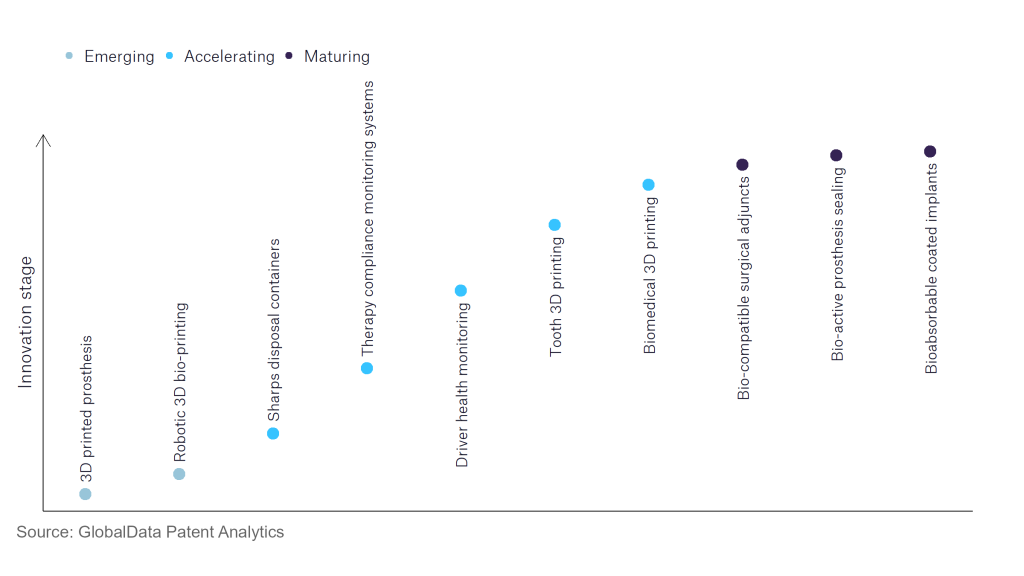The medical devices industry continues to be a hotbed of innovation, with activity driven by increased need for homecare, preventative treatments, early diagnosis, reducing patient recovery times and improving outcomes, as well as a growing importance in technologies, such as machine learning, augmented reality, 5G and digitization. In the last three years alone, there have been over 450,000 patents filed and granted in the medical devices industry, according to GlobalData’s report on Environment Sustainability in Medical Devices: Sharps disposal containers.
However, not all innovations are equal and nor do they follow a constant upward trend. Instead, their evolution takes the form of an S-shaped curve that reflects their typical lifecycle from early emergence to accelerating adoption, before finally stabilizing and reaching maturity.
Identifying where a particular innovation is on this journey, especially those that are in the emerging and accelerating stages, is essential for understanding their current level of adoption and the likely future trajectory and impact they will have.
150+ innovations will shape the medical devices industry
According to GlobalData’s Technology Foresights, which plots the S-curve for the medical devices industry using innovation intensity models built on over 550,000 patents, there are 150+ innovation areas that will shape the future of the industry.
Within the emerging innovation stage, 3D printed prosthesis and robotic 3D bio-printing are disruptive technologies that are in the early stages of application and should be tracked closely. Sharps disposal containers, therapy compliance monitoring systems, and driver health monitoring are some of the accelerating innovation areas, where adoption has been steadily increasing. Among maturing innovation areas are bio-compatible surgical adjuncts and bio-active prosthesis sealing, which are now well established in the industry.
Innovation S-curve for environmental sustainability in the medical devices industry

Sharps disposal containers is a key innovation area in environment sustainability
Sharps disposal containers are used to dispose of sharp and contaminated medical waste, such as needles, syringes, IV catheters, and disposable scalpels. The containers are leak-proof and puncture-resistant and are recommended to be used instead of regular plastic containers to avoid the risk of injury and infections. While these containers have been around for many years, new technological enhancements are improving the environmental impact of the waste associated with these essential containers.
GlobalData’s analysis also uncovers the companies at the forefront of each innovation area and assesses the potential reach and impact of their patenting activity across different applications and geographies. According to GlobalData, there are 20+ companies, spanning technology vendors, established medical devices companies, and up-and-coming start-ups engaged in the development and application of sharps disposal containers.
Key players in sharps disposal containers – a disruptive innovation in the medical devices industry
‘Application diversity’ measures the number of different applications identified for each relevant patent and broadly splits companies into either ‘niche’ or ‘diversified’ innovators.
‘Geographic reach’ refers to the number of different countries each relevant patent is registered in and reflects the breadth of geographic application intended, ranging from ‘global’ to ‘local’.
Becton Dickinson is one of the leading patent filers in the field of sharps disposal containers. Some other key patent filers in the field include Viatris and Sanofi.
In terms of application diversity, Carl Zeiss Stiftung leads the pack, followed by Fresenius and Daikyo Seiko. By means of geographic reach, Sarstedt holds the top position, followed by Viatris and Owen Mumford in the second and third spots, respectively.
Sharps disposal containers are used to safely dispose of medical wastes from hospitals to autoclaves or incinerators. With technological advancements, disposal containers can be designed to be processed and recycled easily, posing fewer negative environmental and health concerns.
To further understand the key themes and technologies disrupting the medical devices industry, access GlobalData’s latest thematic research report on Medical Devices.
This content, Environmental Sustainability Innovation: Leading Companies in Sharps Disposal Containers, was originally shared by Medical Device Network on February 17, 2023.











